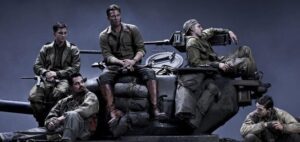Released in 2014, David Ayer’s “Fury” takes viewers on a brutal and immersive experience through the final days of World War II in Europe. Starring Brad Pitt as grizzled tank commander Don “Wardaddy” Collier, the film depicts the physical and psychological toll of war on a tank crew fighting behind enemy lines in Nazi Germany.
A Baptism by Fire: New Recruit Norman and the Horrors of War
The film opens with the arrival of Norman Ellison, a wide-eyed rookie thrust into the chaos of Wardaddy’s seasoned crew.
“Fury” transcends mere action spectacle by delving into the emotional weight borne by soldiers. Each crew member carries invisible scars, their past actions and losses shaping their present choices. Wardaddy, hardened by years of combat, embodies the emotional cost of leadership, his ruthlessness masking a flicker of humanity. Bible, grappling with his faith and violent actions, seeks solace in scripture. The film explores the camaraderie and dark humour that bind the crew together, a coping mechanism in the face of constant death.
Confined Chaos: The claustrophobic Reality of Tank Warfare
The film excels in its depiction of tank warfare, placing viewers within the cramped confines of the Sherman tank named “Fury.” The constant tension, loud sounds, and limited visibility create a visceral experience, immersing the audience in the chaos and fear of battle. Ayer’s camerawork masterfully portrays the claustrophobia and vulnerability of tank warfare, where one wrong move can mean destruction.
Moral Ambiguity and the Question of Humanity
“Fury” doesn’t shy away from depicting the moral ambiguity of war.
Despite the film’s focus on combat, “Fury” also explores themes of humanity and redemption.

Enduring Impact: A Powerful Exploration of War and its Aftermath
“Fury” is not an easy film to watch.

